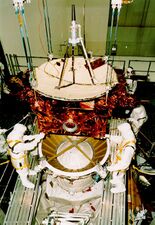Payload Assist Module
Topic: Engineering
 From HandWiki - Reading time: 3 min
From HandWiki - Reading time: 3 min
The Payload Assist Module (PAM) is a modular upper stage designed and built by McDonnell Douglas (now Boeing), using Thiokol Star-series solid propellant rocket motors. The PAM was used with the Space Shuttle, Delta, and Titan launchers and carried satellites from low Earth orbit to a geostationary transfer orbit or an interplanetary course. The payload was spin stabilized by being mounted on a rotating plate.[1] Originally developed for the Space Shuttle, different versions of the PAM were developed:
- PAM-A (Atlas class), development terminated; originally to be used on both the Atlas and Space Shuttle, designed for satellites up to 4,400 lb (2,000 kg)
- PAM-D (Delta class), uses a Star-48B rocket motor, designed for satellites up to 2,750 lb (1,250 kg)[2]
- PAM-DII (Delta class), uses a Star-63 rocket motor, designed for satellites up to 4,150 lb (1,880 kg)[2]
- PAM-S (Special) as a kick motor for the space probe Ulysses[2]
The PAM-D module, used as the third stage of the Delta II rocket, was the last version in use. As of 2018, no PAM is in active use on any rockets.
2001 re-entry incident
On January 12, 2001, a PAM-D module re-entered the atmosphere after a "catastrophic orbital decay".[3] The PAM-D stage, which had been used to launch the GPS satellite 2A-11 in 1993, crashed in the sparsely populated Saudi Arabian desert, where it was positively identified.[3]
Gallery
SBS-3 satellite with PAM-D stage being launched from Space Shuttle Columbia
References
- ↑ "Payload Assist Module (PAM)". Global Security. http://www.globalsecurity.org/space/systems/pam.htm.
- ↑ 2.0 2.1 2.2 Krebs, Gunter D.. "PAM-D, PAM-D2, PAM-S". https://space.skyrocket.de/doc_stage/pam-d.htm.
- ↑ 3.0 3.1 "PAM-D Debris Falls in Saudi Arabia". The Orbital Debris Quarterly News (NASA Johnson Space Center) 6 (2): 1. April 2001. https://orbitaldebris.jsc.nasa.gov/quarterly-news/pdfs/odqnv6i2.pdf.
External links
- Payload Assist Module at the NASA Shuttle Reference Manual
- Payload Assist Module at GlobalSecurity.org
 |
 KSF
KSF







